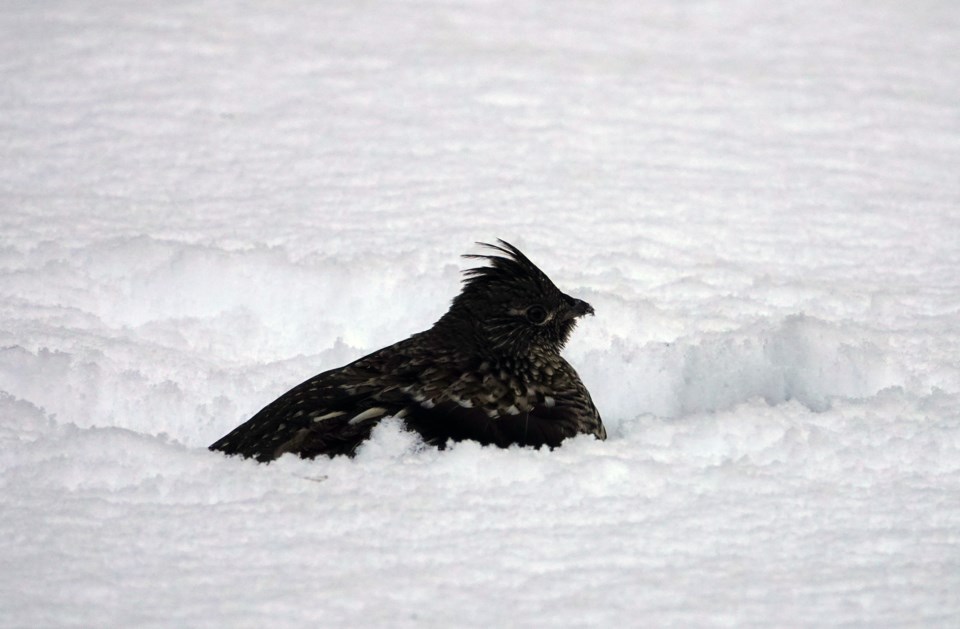I think the ruffed grouse is the epitome of any collection of survival tactics to be displayed by a wildlife species. From camo colouration to seasonal behaviour changes, this bird knows all the tricks to avoid being picked off by a hungry predator.
While they don’t change their feather colours to match the season (such as ptarmigan of the far north that swing from summer brown to winter white) ruffed grouse have the ability to blend in with the natural shadows of either a balsam fir swamp or a dense maple forest. Their black, brown, tan, grey, and white mottled pattern seems to match any background they may wander through.
While their plumage is quite distinctive there is a slight shift on overall colouration between northern and southern birds: birds of the north tend to be grey overall to blend in with snow shadows, while birds of the south tend to be brown overall to blend in with dead leaves.
I don’t know how many of you have studied the fine art of camouflaging, but you can take a good lesson from these grouse. The trick of a good pattern design is not to create a uniform pattern. There should be an ‘unexpected’ disruption to an otherwise repeating pattern, such as a large black area amidst the finer variations. Ruffed grouse do this with their namesake, a black ruff.
A ruff was invented in early Elizabethan times, not for birds but for humans. A large frilly material was wrapped around the neck to catch food debris and could be removed for washing without having to launder the entire shirt or gown. Nowadays we’d just call it a bib, but early royalty liked to jazz up their wardrobe nomenclature.
So a ruffed grouse has a black ruff around its neck, which can be fluffed up when excited or laid flat when just wandering about. This feature differentiates the name of this bird from being called a ruffled grouse, which could be applied, I guess, to a ticked off grouse. It’s an “L” of a way to separate the words.
These birds have a unique way of preparing for winter in that they grow snowshoes. The foot of a bird is covered in scales (the leftover dinosaurian DNA that still floats in their blood) and grouse grow large scales along the outer edges of each toe. This extra wide foot-sizing allows the bird to walk about the surface of the snow without sinking in too deep. Pretty cool, I think.
The recent snowfall was a great help for our local grouse, as it provided a much enjoyed shelter for them. Although capable of perching on a branch for their night’s roost (like turkeys, crows, jays and others) ruffed grouse have discovered the wonderful warming characteristic of a snow blanket.
Fluffy snowflakes work best, as the sharp spiked points of each flake lock into its neighbour, leaving tiny air spaces between the flakes. These air spaces, when warmed ever so slightly, melt and lock the flakes in place, thus trapping a pocket of warm air (at least a lot warmer than the minus 15 degrees night air above the snow).
After a fluffy snowfall the grouse will wriggle into the snow and even tunnel a bit to sit for the night, snug in their shelter. They are late risers, letting the morning sun warm things up as much as possible before leaving for another day of bud eating.
However, other critters like foxes and humans often traverse a woodlot looking for things to eat (that would be the fox) or photographer (that would be me). The still-covered up grouse can actually hear our footsteps coming closer, ever closer, closer ... and then it’s time to leave!
With the impression of a land mine going off, the grouse leap upwards and flap their wings loudly, creating a muffled but very loud “whoom” as they lift off! This action startles the fox to step back and miss its chance of pouncing forward; whereas the human photographer, upon catching his breath, thinks that it was good thing to have had a bathroom break prior to venturing outside.
Speaking of bathroom breaks, if undisturbed, the waking grouse relieve themselves of extra weight before popping their heads up through the snow. There are two kinds of grouse poop that you may encounter on your snowshoe outing: dry and cylindrical pellets with a white tip of uric acid; or a brown watery plop.
The dry waste is from undigested bits of buds, leaves, berries and seeds, similar in a way to the pellets passed by hares and rabbits. Good roughage. The wet gooey stuff is way more interesting ... this is the remains of finer and more nutritious plant materials that have entered a two-stage digestion tract called a caeca. Inside the caeca are bacteria that are capable of breaking down the tough plant cellulose, resulting in a watery discharge.
Now you have something to look at and study whilst catching your breath. You’re welcome.



